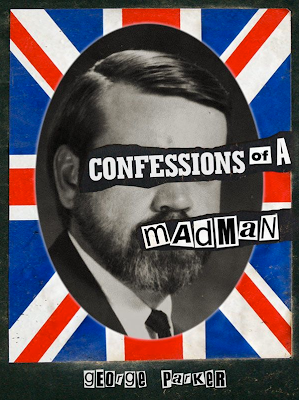I'm a huge fan of Private Eye. I like pretty much everything about it, its daring attitude, two fingers to the establishment. The fact that no one is sacred or untouchable. And I love that it's all still packaged in quite a lo-fi sort of way. I really like the way the Private Eye covers are put together - always very funny or pithy or bluntly to the point, but always very simply - a photo with a speech bubble or a quick and dirty photo comp. I think that visceral, very bare way of putting across points or thoughts of jokes is something that advertising people sometimes forget to do. Everything is so slickly put together or crafted to within an inch of its life. Sometimes that squeezes the energy out of the original thought.
Anyway, not surprisingly, when I heard they were having an exhibition at the V&A to celebrate the 50th birthday of the magazine, I had to pop along to see for myself. If you're a fan of the Eye it's well worth a visit, just to see the collection of classic covers chosen by Ian Hislop. But also there's also a fantastic display of original cartoon and illustration artwork by the likes of Willie Rushton, Ralph Steadman and Gerald Scarfe. It's really great to see them in the flesh, with all of their corrections and redraws. Also there's a mock-up of the old production table with original paste-up artwork, and a recreation of the editor's office.
'Engagement' Dissected
Engagement has become one of those fashionable bullshit terms that people spout to try to sound current or interesting. Often these same halfwits proclaim the end of interruptive advertising as an effective way of marketing. 'Engagement': Fashionable Yet Bankrupt by Martin Weigel, Head of Planning at Wieden + Kennedy, Amsterdam is the most thorough and well-researched and dissection of the claims of the engagement bullshitters that I've read. Well worth a read if you are so inclined.
Found via Bob.
Found via Bob.
Confessions of a (Thoroughly) Mad Man
One of my moany old complaints about the current ad business is that it seems so damn safe, corporate and vanilla for a so-called creative industry. Where are the mavericks willing to stick their necks out, or the companies daring to be a bit different? No doubt edged out by the normal Nigels who are just desperate to climb the corporate ladder, or to do the right work to win the right award.
This is one of the reasons why I enjoyed George Parker’s new book Confessions of a Mad Man. In it George tells us the story of his career in this God-forsaken business, punctuated by boozed-filled anecdotes and funny asides. It’s a window back into a time when the advertising business seemed to have more characters, and on the surface of it, more fun. Whilst in the middle of it all - doing work that had more of a point to it. Maybe that's because it was a less grown-up business back then? Who knows? Not me.
Anyway, if you haven’t read it yet, it’s well worth it – you can get it here. And if you don't already read George’s piss and vinegar blog Adscam, it’s right here.
Bill Bernbach Said #42
Number 42 in our Bernbach series...
“To keep your ads fresh you’ve got to keep yourself fresh. Live in the current idiom and you will create in it. If you follow and enjoy and are excited by the new trails in art, in writing, in industry, in personal relationships ... whatever you do will naturally be of today.”
Read all of the previous Bernbach Said posts here.
“To keep your ads fresh you’ve got to keep yourself fresh. Live in the current idiom and you will create in it. If you follow and enjoy and are excited by the new trails in art, in writing, in industry, in personal relationships ... whatever you do will naturally be of today.”
Read all of the previous Bernbach Said posts here.
New York in 1941
A small selection of shots from the Charles W. Cushman Photograph collection. These are all from New York, some from the 1940s and some from the 1960s. It's an amazing collection of photography, theres some great shots of London in the 60s as well.
Bob Hoffman On Postcoherent Advertising
Have a read of this great post from Bob Hoffman. A small snippet to whet your appetite: “The primary characteristics of postcoherent advertising is that it assumes... we already know what the product is, or what it's for, or how it works, or why it's better, or why we need it”.
Subscribe to:
Comments (Atom)

















